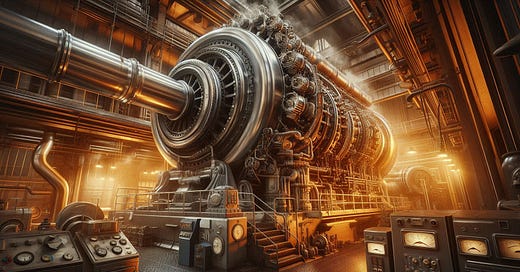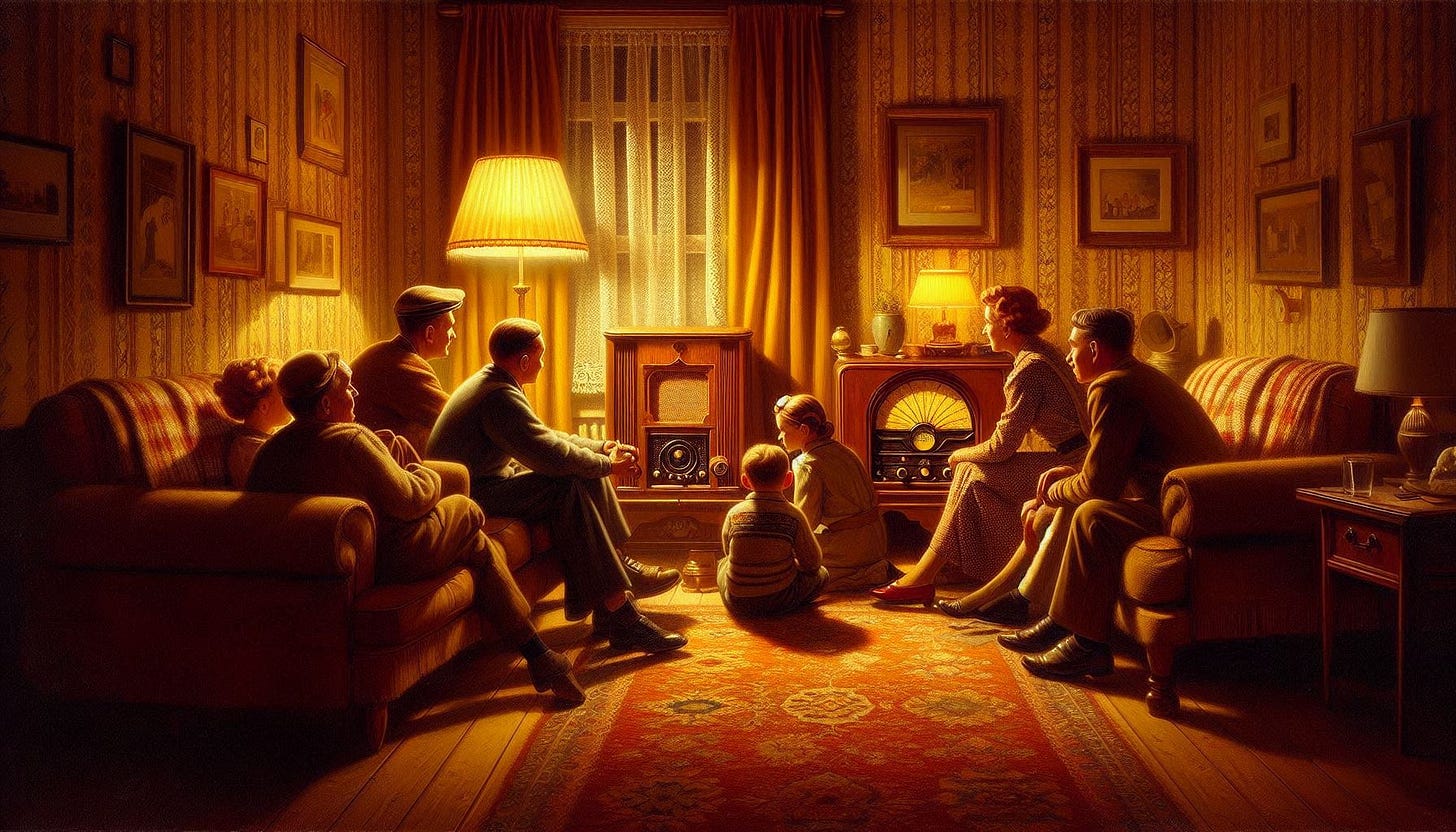General Electric - Part 1
The first of a three-part series on General Electric - the iconic American conglomerate that transformed our lives, became the world's most valuable company, and shaped people's view of capitalism.
**This post is not investment advice. Please see the full disclosure on the About page**
Long before it became fashionable for companies to talk about changing the world, one company did precisely that. For more than one hundred years, General Electric transformed one industry after another and shaped how people lived, worked, and travelled. GE electrified the world—its turbines, nuclear reactors, and transformers powered the modern electrical grid, while its vast array of consumer appliances made lives more convenient and enjoyable. The company’s reach extended far beyond electricity. Its jet engines kept planes in the air, its medical equipment helped doctors spot cancers and heart defects, and its broadcasting division produced hit TV shows like Friends. For many years, leveraging a credit rating on par with the U.S. government, GE Capital financed everything from credit cards to real estate (including the Trump International Hotel and Tower in New York) to corporate buyouts. No corner of the economy was untouched by GE. By the turn of the 21st century, GE’s success made it the most valuable company in the world.
The birth of General Electric
While General Electric can trace its roots to Thomas Edison, the Wizard of Menlo Park played a relatively minor role in the company. Instead, GE’s first leader was a man named Charles Albert Coffin. Born in Fairfield, Maine, in 1844, Coffin moved to Lynn, Massachusetts, at the age of eighteen to work for his uncle’s shoe business. He was an excellent businessman and soon set his sights on bigger things. In the 1880s, electricity was the high-tech industry of its time, with electric lights and street cars appearing in towns and cities across America. In 1883, Coffin seized the opportunity to recapitalise the American Electric Company, a maker of dynamos and electric arc lights co-founded by teacher-turned-inventor, Elihu Thomson. Captivated by the new industry, Coffin sold his shoe business for $300,000 to focus full-time on the venture, which was renamed to the Thomson-Houston Electric Company. He consolidated the industry through acquisitions, buying up his rival Charles Brush’s company and the Van Depoele Electric Manufacturing Company. Soon, Coffin was bumping up against industry titans George Westinghouse and Thomas Edison.
By 1891, at the urging of his backers, including the powerful financier J. Pierpont Morgan, Edison had consolidated most of his companies into the Edison General Electric Company. The year before, Coffin had discussed the possibility of a merger with Henry Villard, Edison General Electric’s President, but Edison was against the idea and killed the discussion. In 1892, with J.P. Morgan’s support, Coffin and Villard revived the merger talk. This time, Edison was powerless to stop it. On April 15, 1892, the General Electric Company was formed through the merger of Edison General Electric and Thomson-Houston. Coffin was elected as the company’s President while Edison joined the board. Dispirited by losing control of his company, Edison sold his shares in General Electric the next year and focused on his other ventures in mining and motion pictures.
The newly formed General Electric Company, employing 10,000 people and generating $20 million in revenue, almost went under as soon as it was born. Barely nine months after the merger, the Panic of 1893 gripped the nation. The burst of the railroad bubble and crop failures in the Midwest caused a severe recession. The unemployment rate soared, and the U.S. Treasury almost ran out of gold. At GE, orders plummeted by 75%, and despite laying off two-thirds of the workforce, the company still had to borrow money to meet payroll. By the summer of 1893, GE's cash reserves had shrunk to $1.3 million while its debt ballooned to $10 million. To survive, Coffin sold at a substantial discount the bonds and stocks of General Electric’s customers. Until then, it was common for power and lighting companies to pay for GE’s goods by issuing bonds and equity. The cash infusion from the sale of those securities saved the company.
Coffin wasn’t simply a finance whizz; he also had a keen eye for technology. After navigating the Panic of 1893, Coffin invited Charles G. Curtis, a New York City engineer, to Schenectady—GE’s spiritual home—to develop a new machine for generating electricity. Curtis’s creation would become the precursor to the modern steam turbine, a product that would underpin GE’s profits for over a century. In exchange for the right to purchase his patents, Coffin allowed Curtis to use GE’s research facilities and assigned engineers to support the project. After trials and errors, the effort paid off. In 1900, the first turbine was installed at the Commonwealth Edison Company in Chicago.
In the early 1900s, General Electric solidified its position in the electrical equipment industry, cementing a duopoly with Westinghouse. The company made several strategic acquisitions, including the U.S. operations of Siemens-Halske and Allis-Chalmers, a major competitor in electrical and power equipment. In 1913, after leading the company for twenty-one years, Coffin stepped down as GE's President. Under his leadership, GE’s revenue had grown to $106 million with profits reaching $10 million.
General Electric played a major role in America’s World War I efforts. GE executives assumed positions in government, laying the groundwork for the country’s military-industrial complex, while the company developed vital military equipment, including submarine detectors, searchlights, and turbochargers for airplane engines. However, the most consequential event occurred after the war, when GE helped to create the Radio Corporation of America (RCA).
Establishing Radio Corporation of America
In the early twentieth century, the British Marconi Company and its U.S. affiliate, American Marconi, dominated radio communication. After the Titanic disaster, Marconi equipment became mandatory on all seagoing vessels, and the British military relied heavily on Marconi equipment during World War I. In 1915, GE scientist Dr. Ernst Alexanderson developed a high-frequency alternator that significantly improved the performance of radio transmission. When he tested his invention at Marconi’s factory in New Jersey, the results were so promising that Guglielmo Marconi offered to purchase the exclusive rights to the Alexanderson alternator. This would have meant millions in revenue for GE, and Owen Young, GE’s President, was eager to seal the deal.
However, World War I and national security concerns derailed the deal. The U.S. Navy, wanting to control the nation's radio communication assets, blocked GE's negotiation with British Marconi. After the war, British Marconi tried to revive talks, and a deal was nearly reached when the Navy, intending to arrest British domination of wireless communication, intervened again.
GE found itself in a difficult position. The American Marconi Company, in which British Marconi had a 25% stake, was the dominant wireless communication company in America. If the deal was blocked, GE would lose its primary customer for the Alexanderson alternator, forcing production to cease. The Navy proposed a solution: create a new American wireless communication company to take control of American Marconi. To achieve this outcome, the U.S. government played hardball. It threatened to ban American Marconi from accessing both the Alexanderson alternator and the Poulsen arc, without which the company would be at a great competitive disadvantage. Simultaneously, the government assisted GE in establishing a new subsidiary, RCA, with the intention of acquiring American Marconi. Edward Nally, American Marconi’s General Manager, realised that his company’s survival depended on GE. In the summer of 1919, Nally and Young travelled to London to negotiate a deal with British Marconi. America’s aggressive tactic was hard for the British to swallow, but there were no other options. By September 1919, British Marconi agreed to sell its stake in American Marconi to GE for $2 million. Up to that point, the British controlled international communication through the Marconi companies, but GE, backed by the American government’s support, changed that.
In the decade following GE’s acquisition of American Marconi, the radio business boomed. In 1921, 75,000 people in the U.S. listened to radio. By 1929, that figure was 40 million. Over this period, the retail value of radios sold in the country rose from $5 million to $650 million. GE, which manufactured radio equipment and operated the National Broadcasting Corporation (NBC), prospered. However, the bonanza was short-lived for GE. In 1932, the Justice Department began investigating the company’s dominance of the radio industry after competitors complained that they couldn’t access RCA’s patents at any price. GE quickly settled the lawsuit by agreeing to spin out RCA as an independent company.
The divestiture of RCA proved only a minor setback as GE transformed itself from an electrical equipment company to a diversified industrial business. The company became the world’s largest consumer appliance manufacturer. Its refrigerators, stoves, washing machines, dishwashers, and televisions revolutionised people’s lives. GE also emerged as a healthcare pioneer, introducing a range of medical diagnostic equipment including X-ray imaging and electrocardiograph machines. Building on its experience developing turbochargers for the Air Force, GE entered the aviation industry, eventually becoming a leading supplier of jet engines. In the first half of the twentieth century, GE became a driving force behind America’s economic and social progress.
General Electric's expansion was reflected in its financial performance. Revenue reached $415 million in 1929 with profits of $49 million. After weathering the Great Depression, revenue surpassed $1 billion in 1942. By 1950, GE was generating $2 billion in revenue and $173 million in profits. Just as importantly, management shared this financial success with employees. Like many American companies of the era, GE took pride in looking after its workers. The company established a profit-sharing plan for all employees with more than one year of service and implemented a suggestion scheme that rewarded good ideas. GE also provided life insurance and pension plans and even assisted employees with home purchases. GE’s compassionate employment policies earned the company its nickname: "Generous Electric."
General Electric continued to flourish after World War II. By 1973, revenue had reached $11 billion. That year, Englishman Reg Jones became GE’s new CEO and Chairman. Jones coined the phrase The Benign Cycle of Power, describing how the growth of GE’s appliance business created more demand for electricity, necessitating more generators, turbines, and distribution equipment. This, in turn, drove GE to develop more products that consumed electricity, creating a virtuous cycle of growth. Yet Jones’s most significant legacy came at the end of his tenure when he appointed Jack Welch—then a young and relatively unknown executive—as GE’s next CEO and Chairman. That decision would ultimately transform GE and reshape many people’s view of capitalism itself.





